Lithium Pros LiFePO4 batteries, small boat battery perfection?
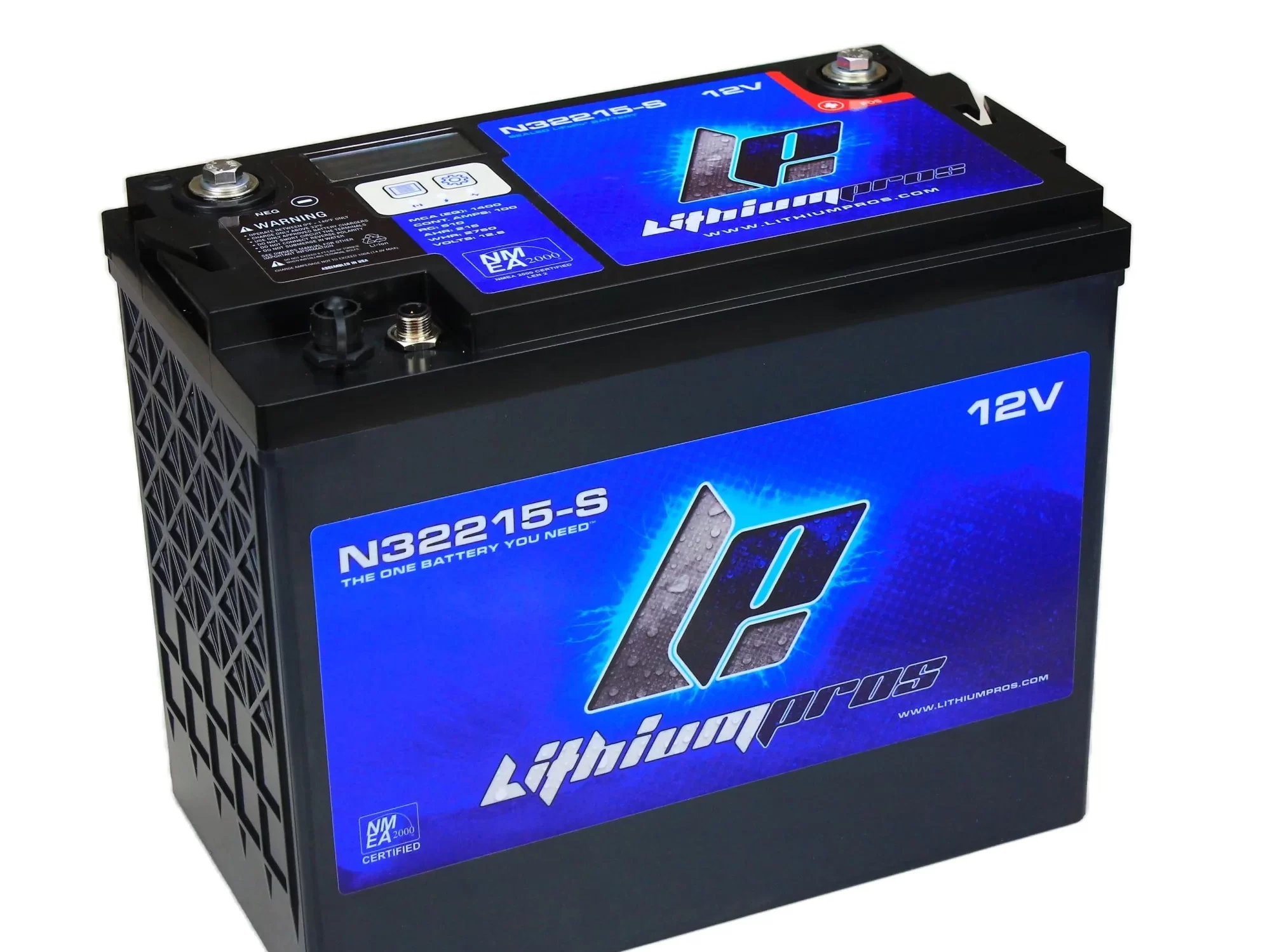
Lithium iron phosphate (LiFePO4 or LFP) batteries are a major upgrade to the lead-acid batteries we’ve been using as house batteries. But, typically, they’re not well suited to starting engines, which has limited their use in smaller boats that use a single battery for starting the engine and running loads onboard. Lithium Pros has a series of batteries suited to both these uses and designed specifically for smaller boats. They’ve overcome many of the potential pitfalls with LiFePO4 on small boats. How do they do it? Read on and find out.
Most of the electrical systems and LiFePO4 conversions I’ve covered on Panbo have been on larger boats with multiple battery banks. Typically, we’ve just converted the house bank to LiFePO4 and let the engine start, generator start, and thruster banks remain a lead-acid chemistry.
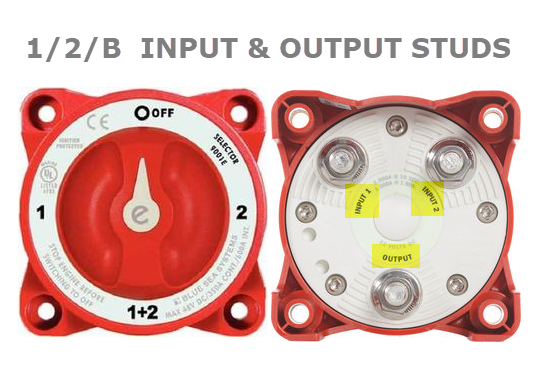
But what about smaller boats with a single battery? Without a battery that supports engine starting, small boat owners cannot take advantage of the benefits of an LFP battery. Panbo(at), for example, came with a 1, 2, both, and off rotary switch. This switch controls all power to the boat, including power going to the engine and all house loads.
When I bought the boat, there was only one battery. That left me uncomfortable that imprudent battery management might leave me unable to start the engine after a day on the water. I considered separating house loads from engine loads, but once I dug into the wiring, I realized it was more work than I was interested in.
In retrospect, I’m glad I didn’t dramatically change the boat’s wiring. Lithium Pros (LP) developed a battery nearly ideally suited to my boat and the hundreds of thousands of other boats like it.
Most LiFePO4 batteries I’ve reviewed and discussed are designed solely for deep-cycle applications. In fact, it’s not uncommon for a battery manufacturer to deny warranty coverage for LFP batteries used to start engines. On larger boats with dedicated house banks, that’s usually manageable. The engine start bank remains lead-acid chemistry while the house bank moves to lithium.
Lithium Pros M and N series batteries
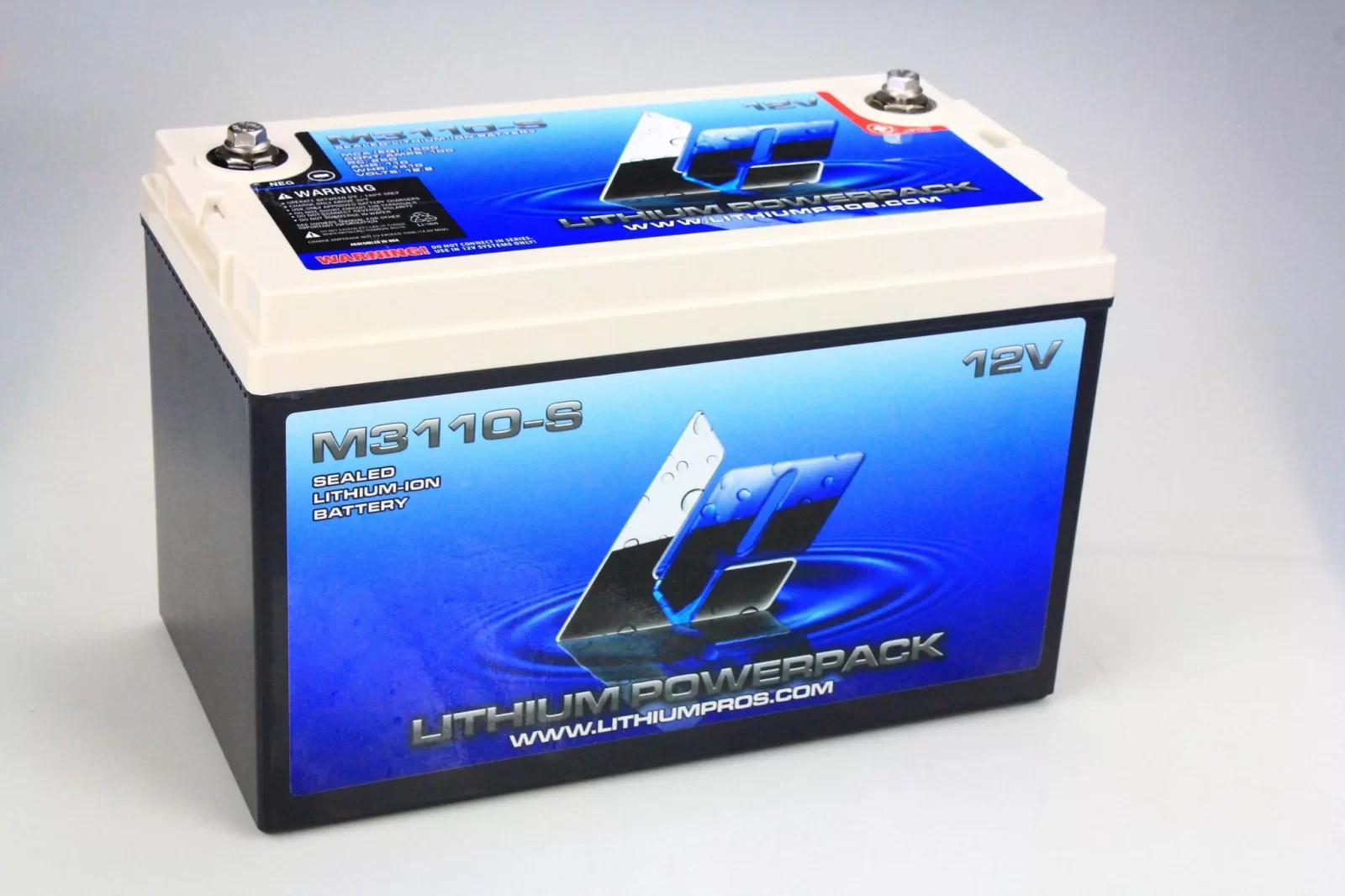
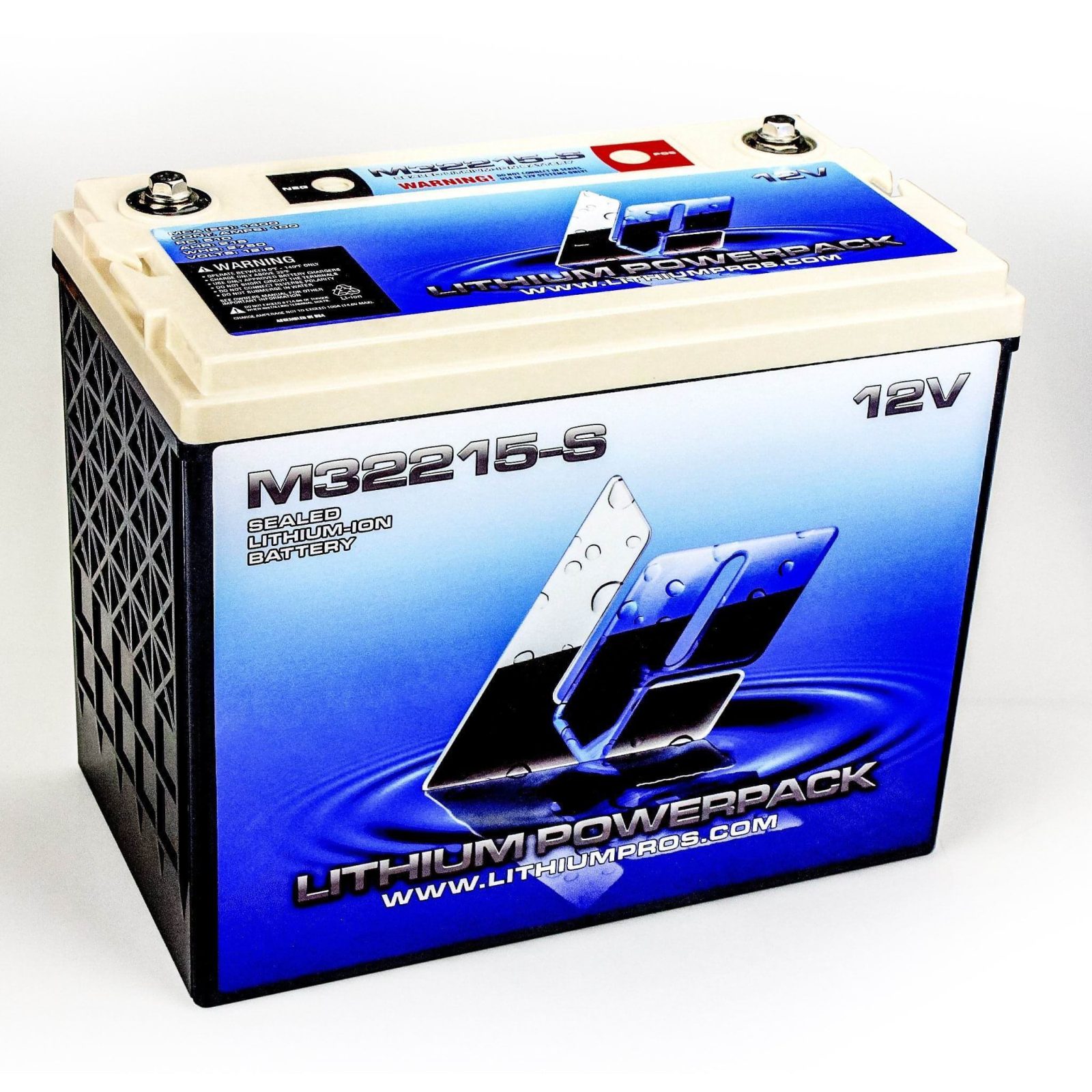

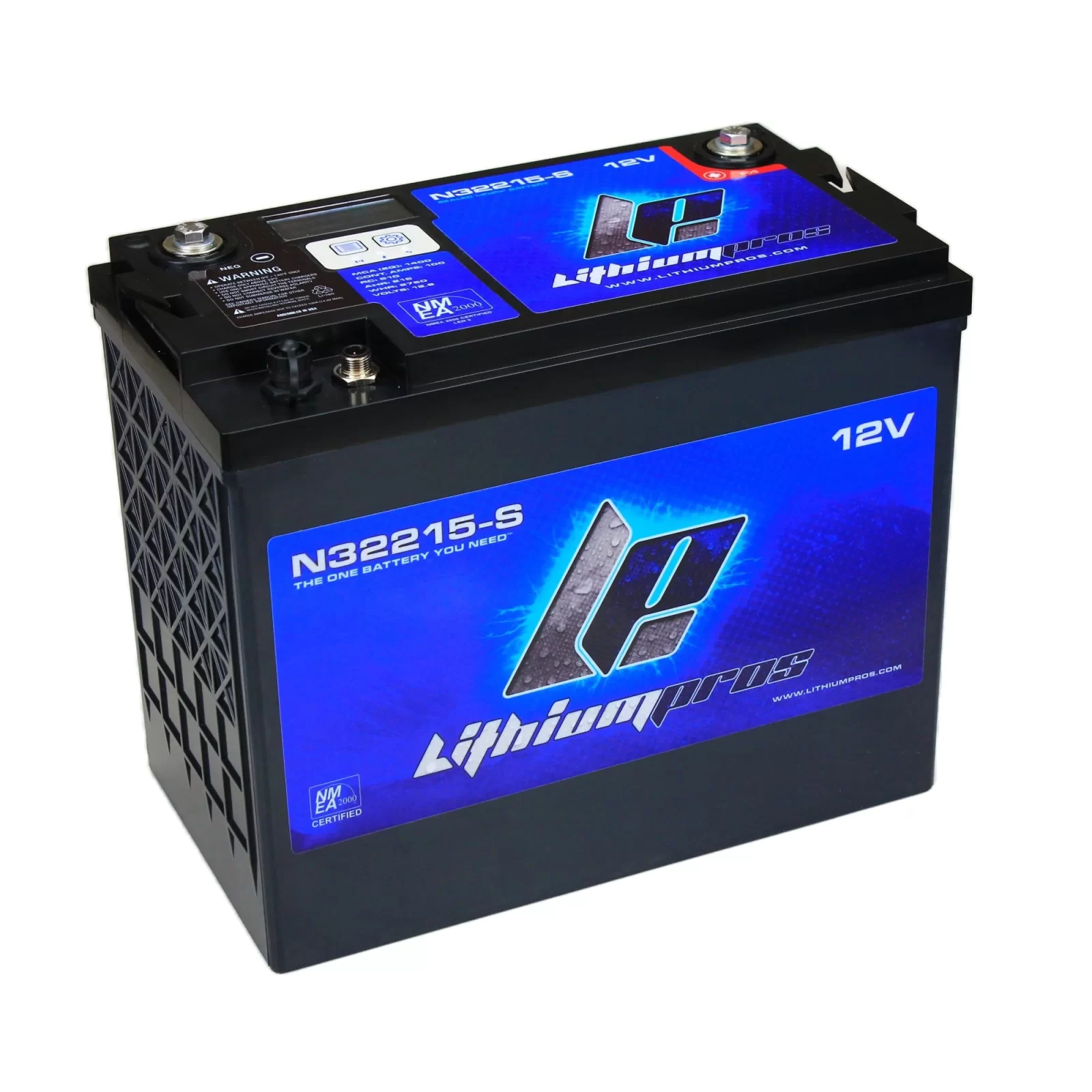
Lithium Pro’s M and N series batteries are designed for use on the water. The M series is the start of their marine line. These batteries are available in 12, 24, and 36-volt configurations. These are nominal voltages, with the actual resting voltage being 12.8, 25.6, and 38.4 volts, respectively. The 12-volt M and N series batteries are also available as starting batteries, denoted with a -S at the end of the model number. LP rates the starting batteries as equivalent to 1,500 marine cranking amps (MCA). For reference, that’s nearly 250 MCA more than a flooded lead-acid 4D starting battery can supply. Plus, the Lithium Pros batteries weigh between 32 and 46 pounds (depending on capacity), while the 4D weighs 100 pounds.
The 12-volt marine batteries come in 110 and 215-amp-hour configurations. The 110-amp-hour model weighs around 32 pounds, while the 215-amp-hour batteries are just over 46 pounds. The smaller battery’s physical dimensions match that of a BCI group 31 battery, and the larger one matches up with a GC12’s physical footprint. The M series batteries are $1,800 for the 110-ah, $2,000 for the 132-ah, and $3,000 for the 215-ah model. The N series batteries are $2,000 for the 110-ah and $3200 for the 215-ah model. The display adds $100 to either size.
NMEA 2000 and displays
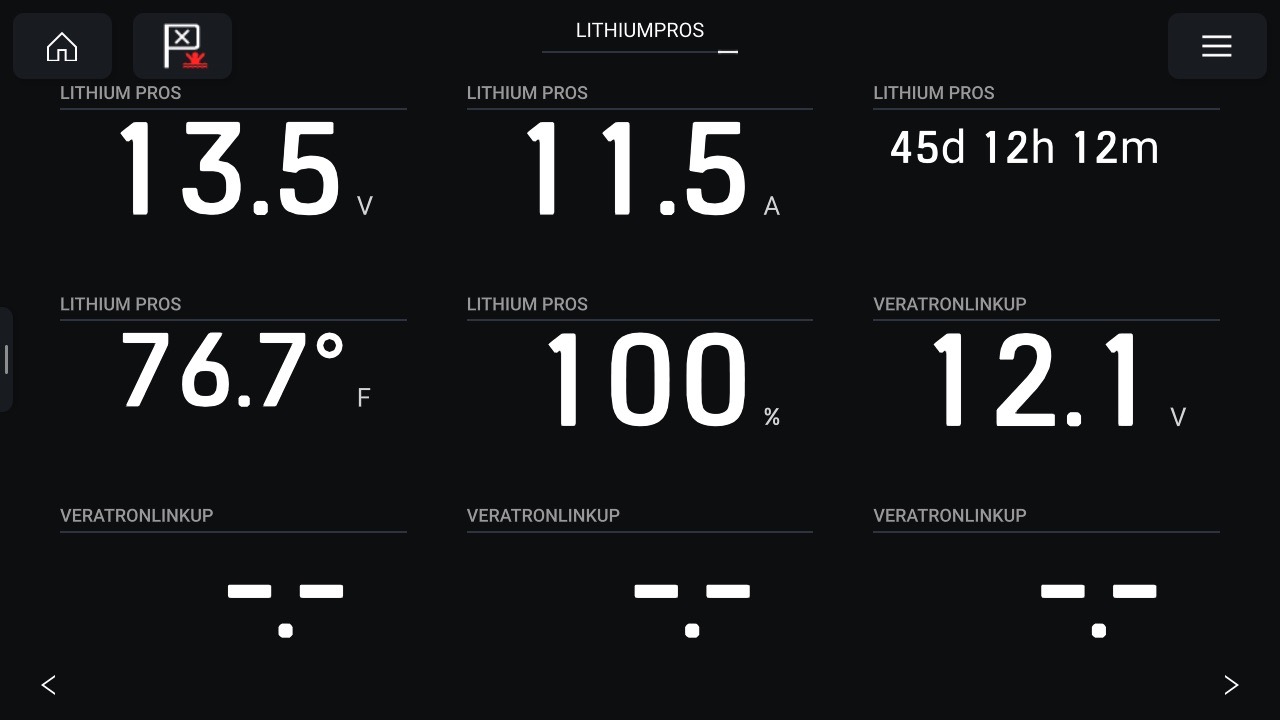
The N series offers everything the M series does, plus NMEA 2000 connectivity. Making battery information available via NMEA 2000 means that any display compatible with NMEA 2000 battery PGNs can show battery info. Above, you can see a Raymarine Axiom showing information on the LP battery.
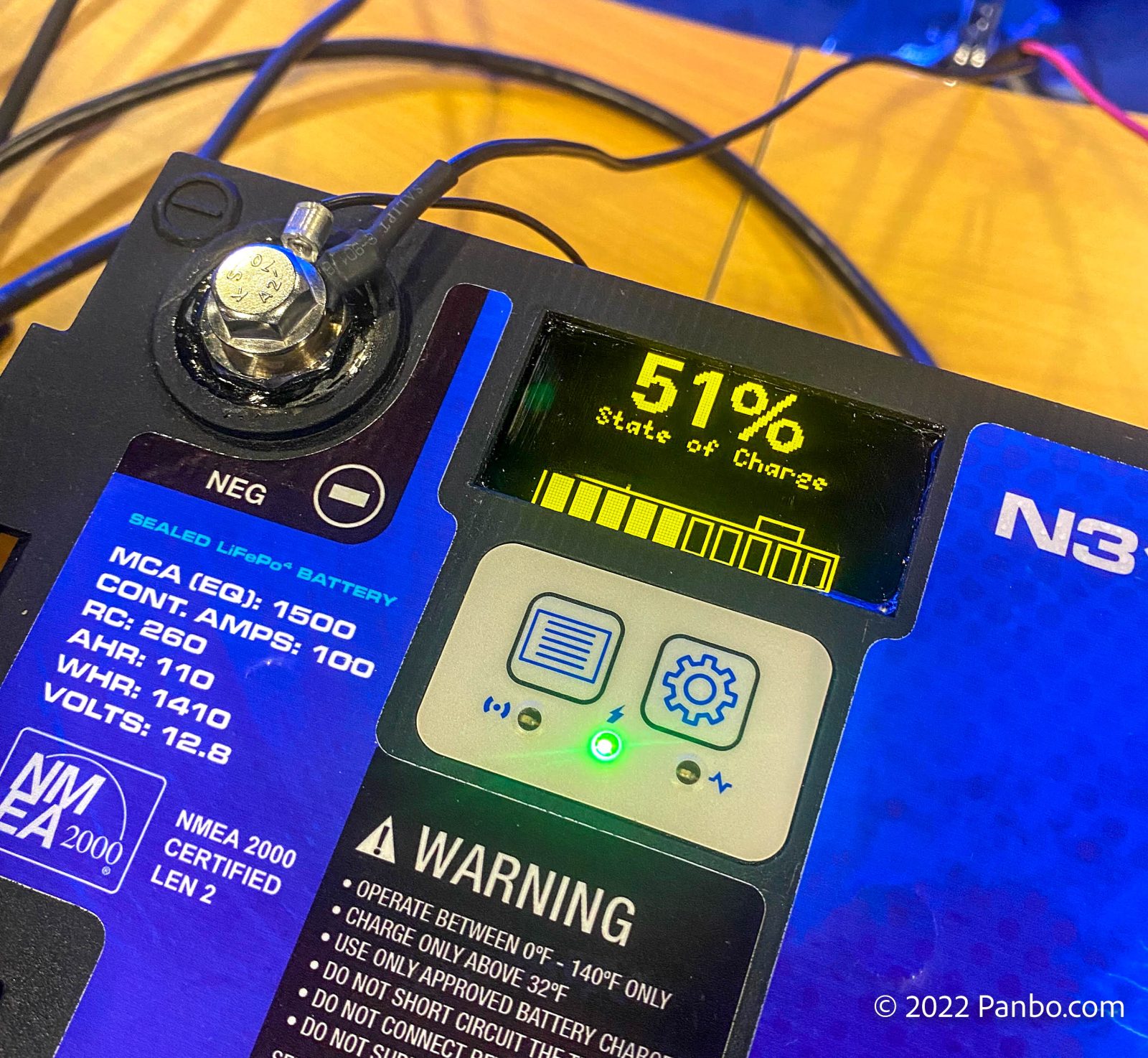
Additionally, the N series is also available with an OLED display on top of the battery. This display allows the boater to glance at the battery’s current status and history quickly.
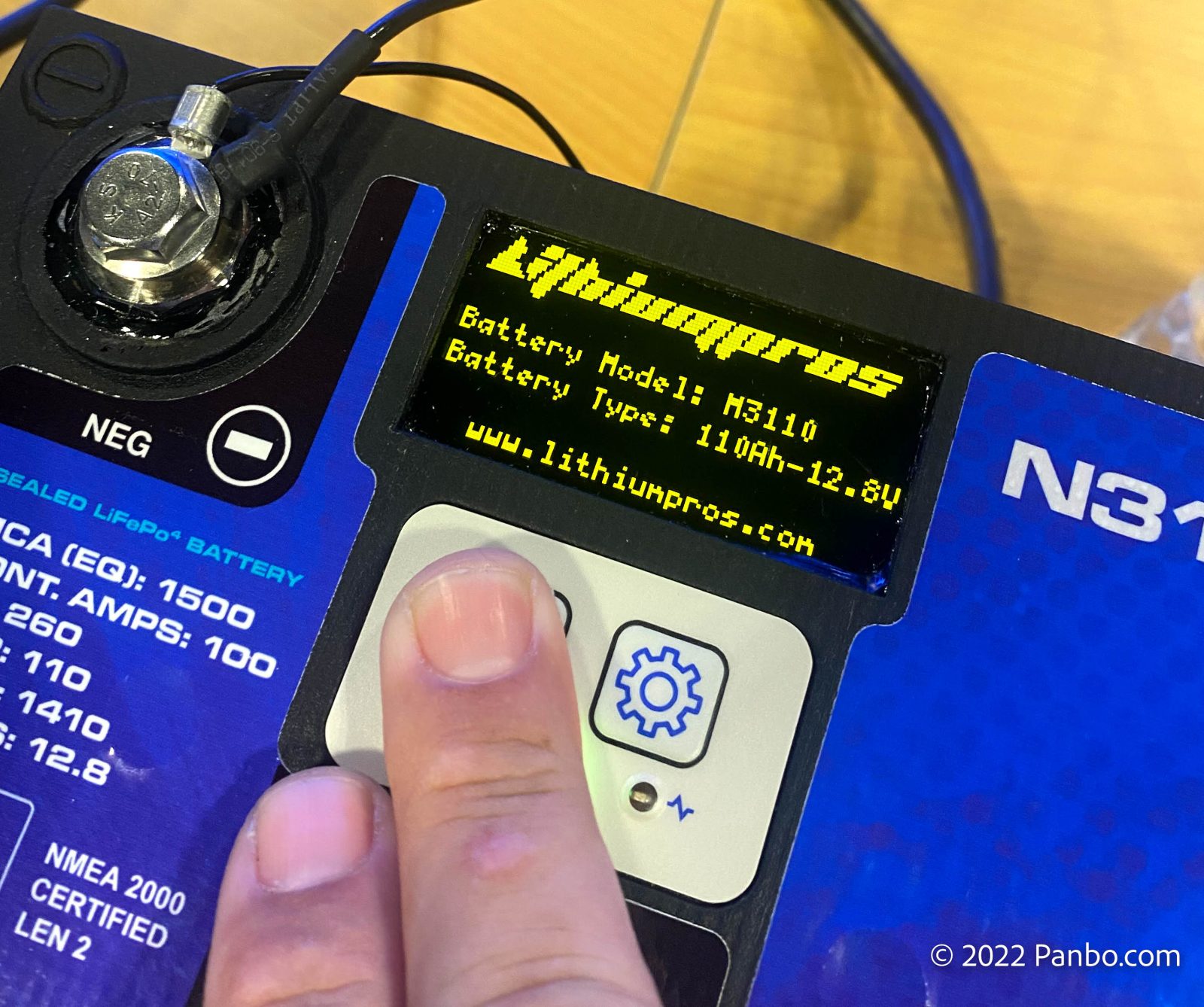

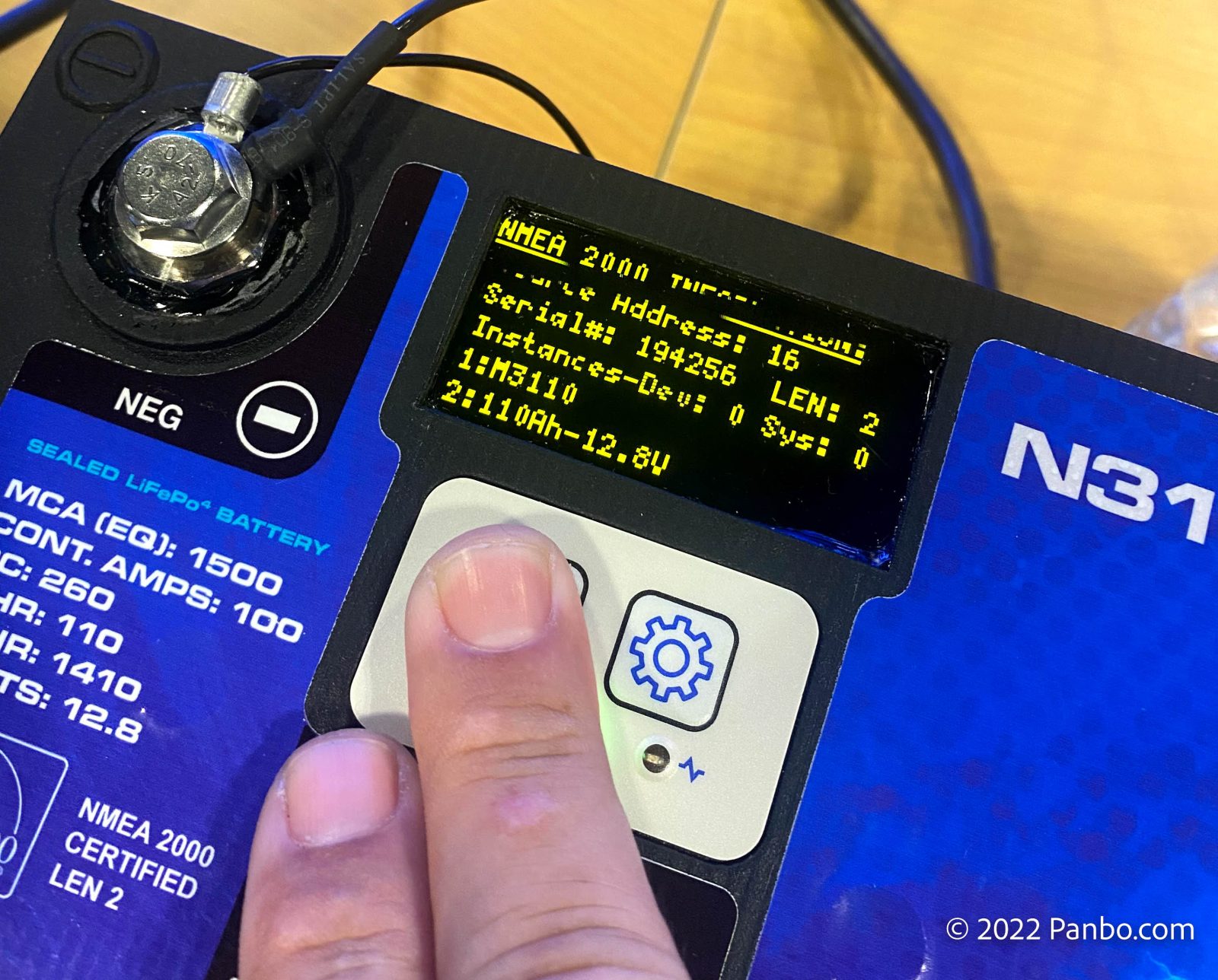
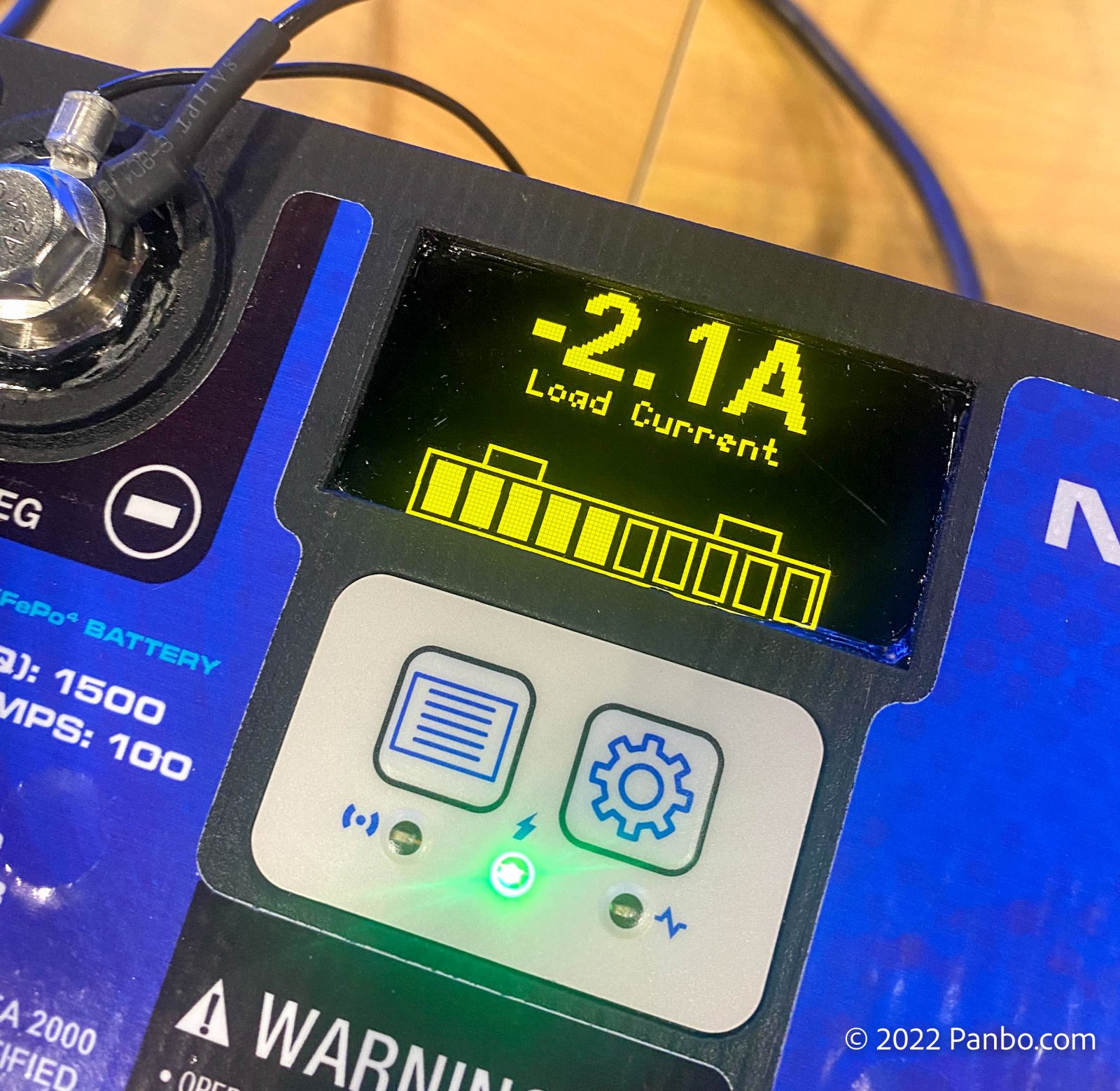
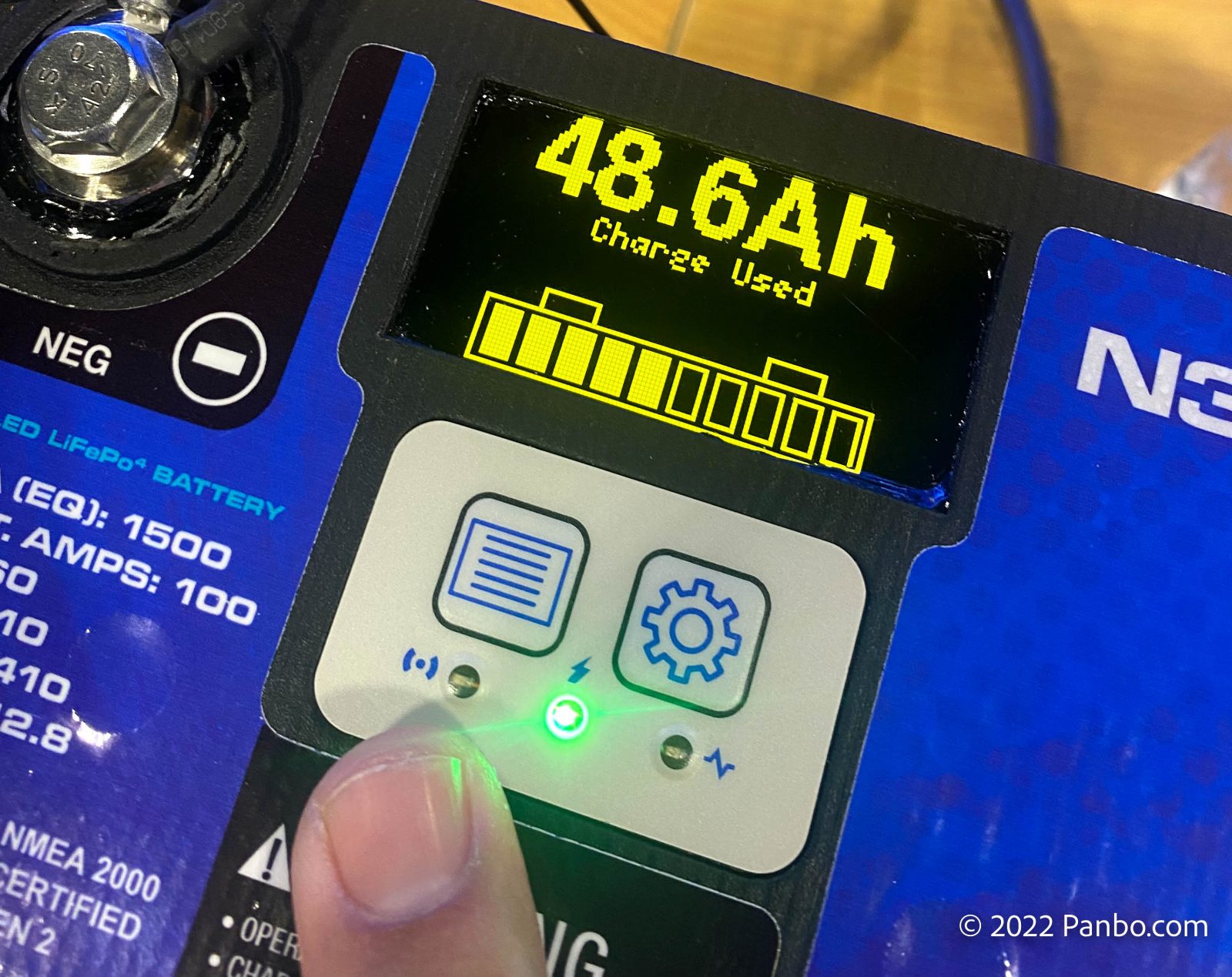
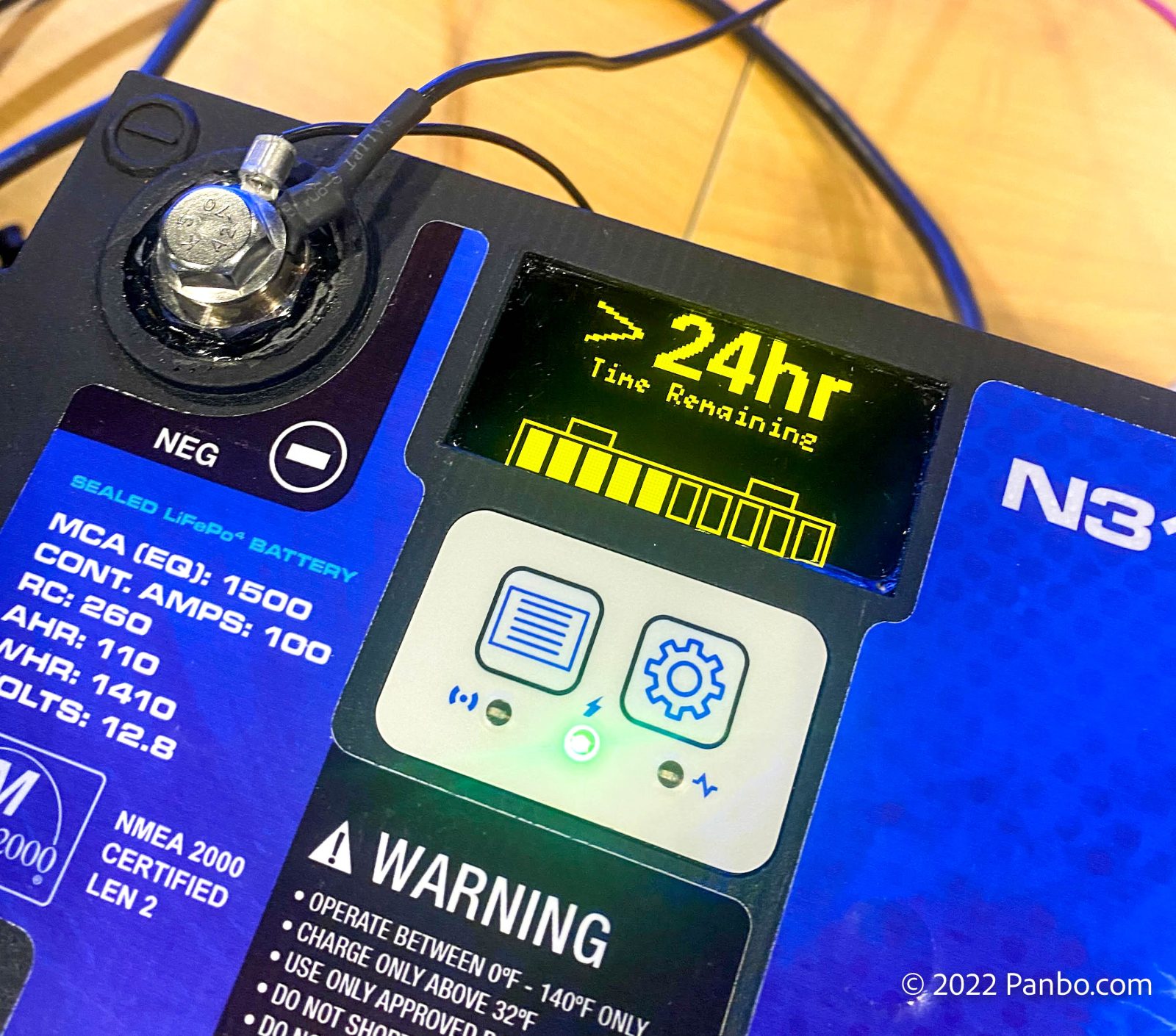
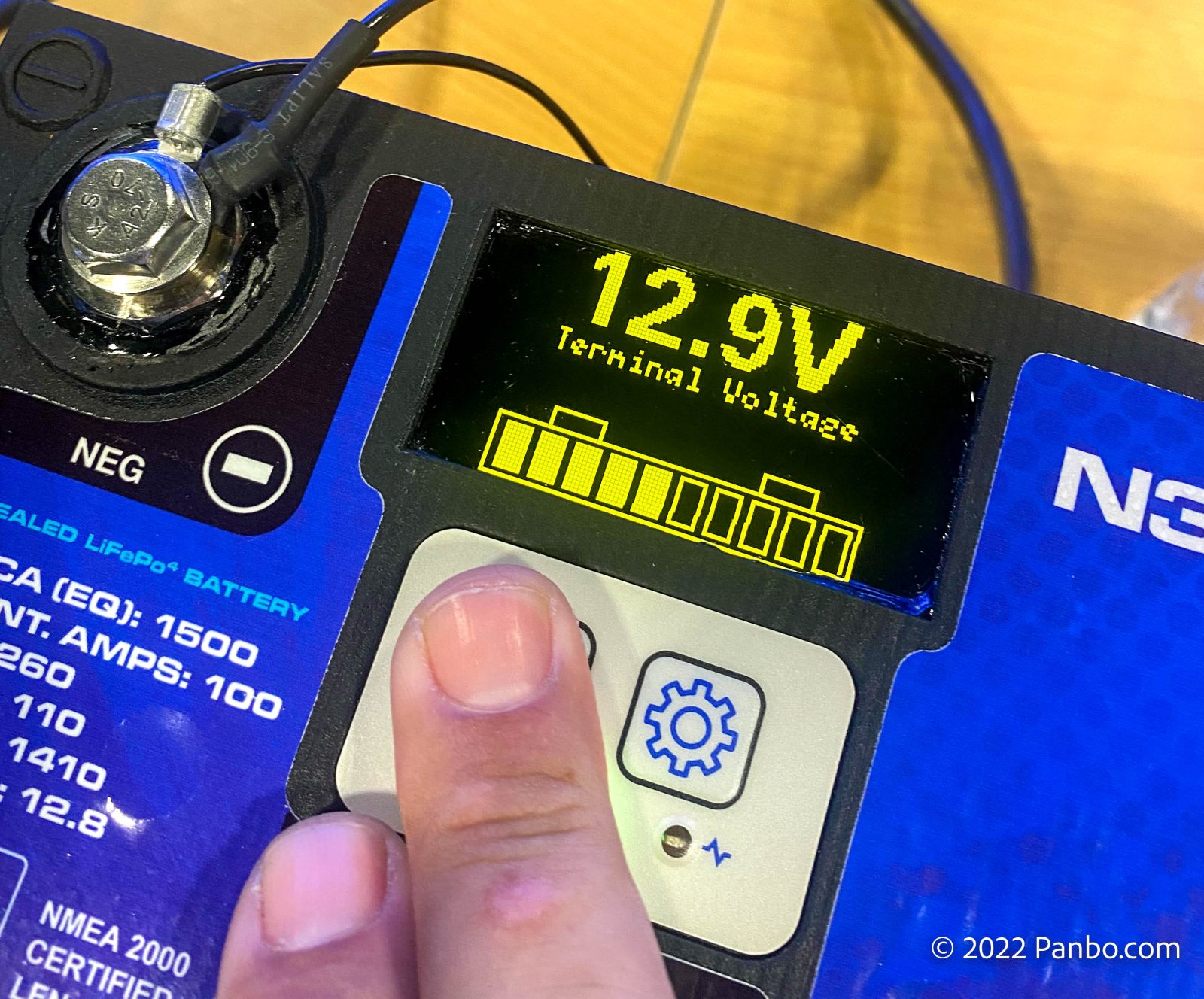
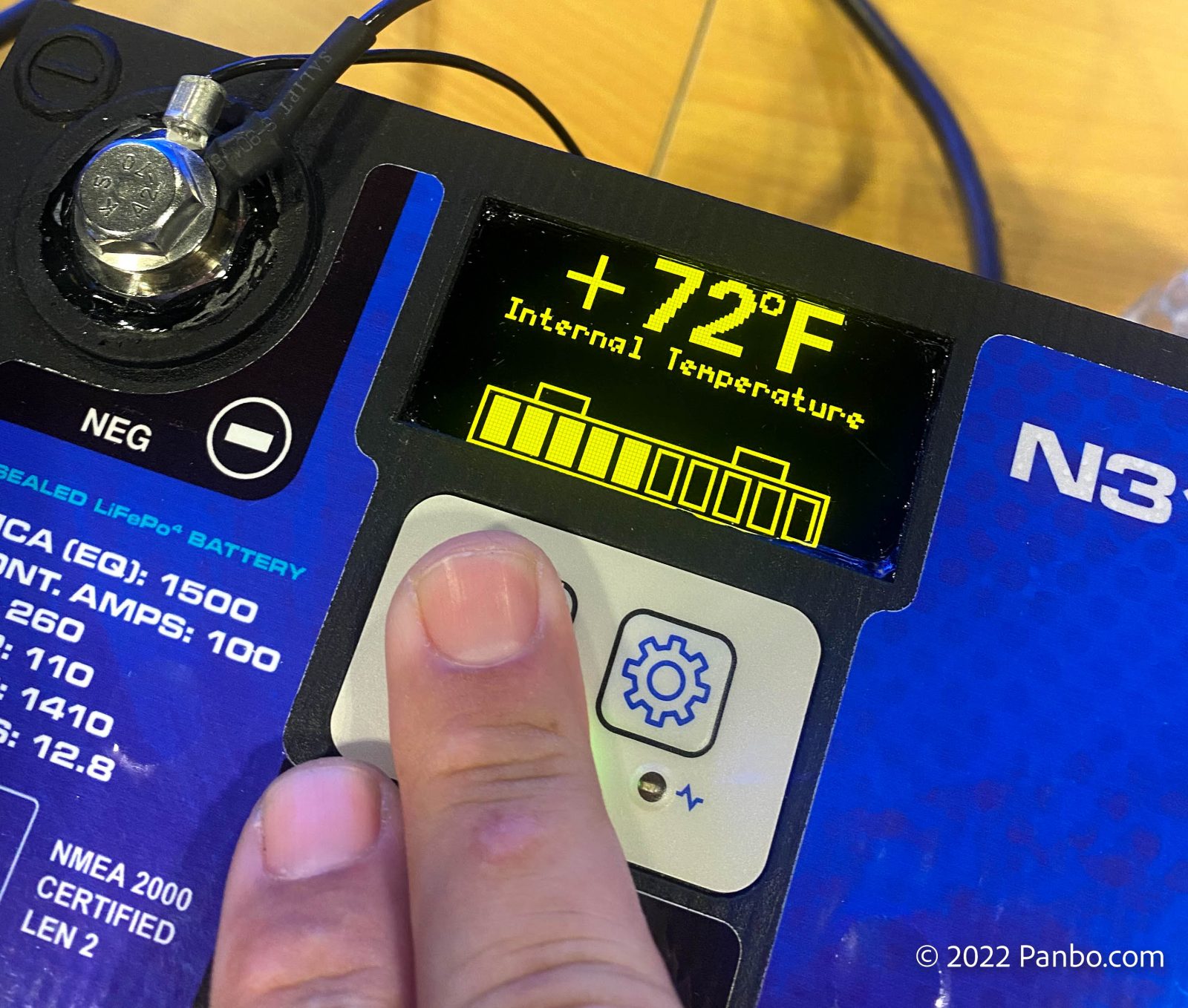
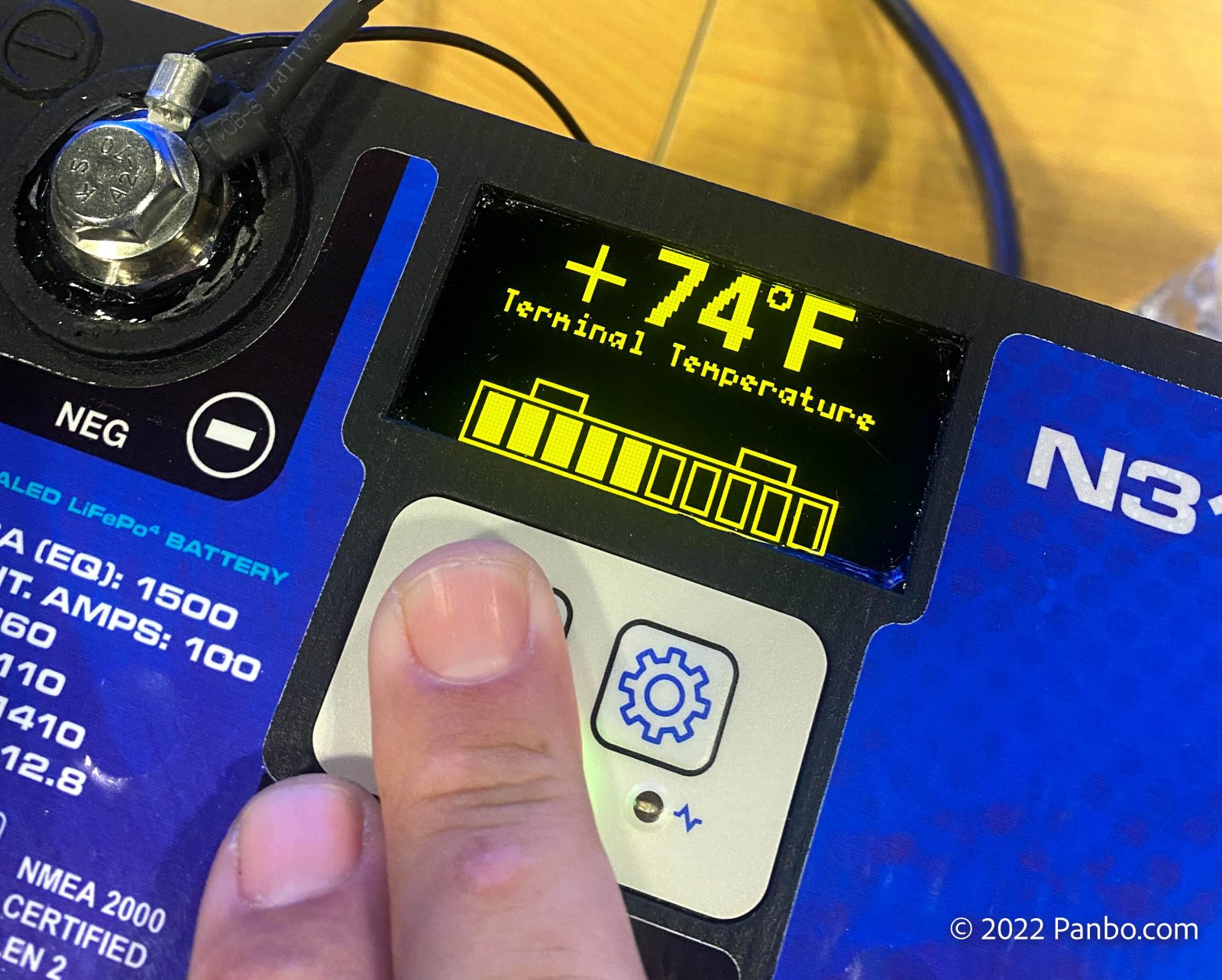
As the gallery above shows, the on-battery display provides in-depth information. I’m a big fan of a total amp-hour counter on any battery. It feels like an odometer for your battery and is an excellent way to keep track of battery usage. Additionally, access to a fault log is particularly helpful and an excellent way to understand a battery’s treatment.
Using the battery
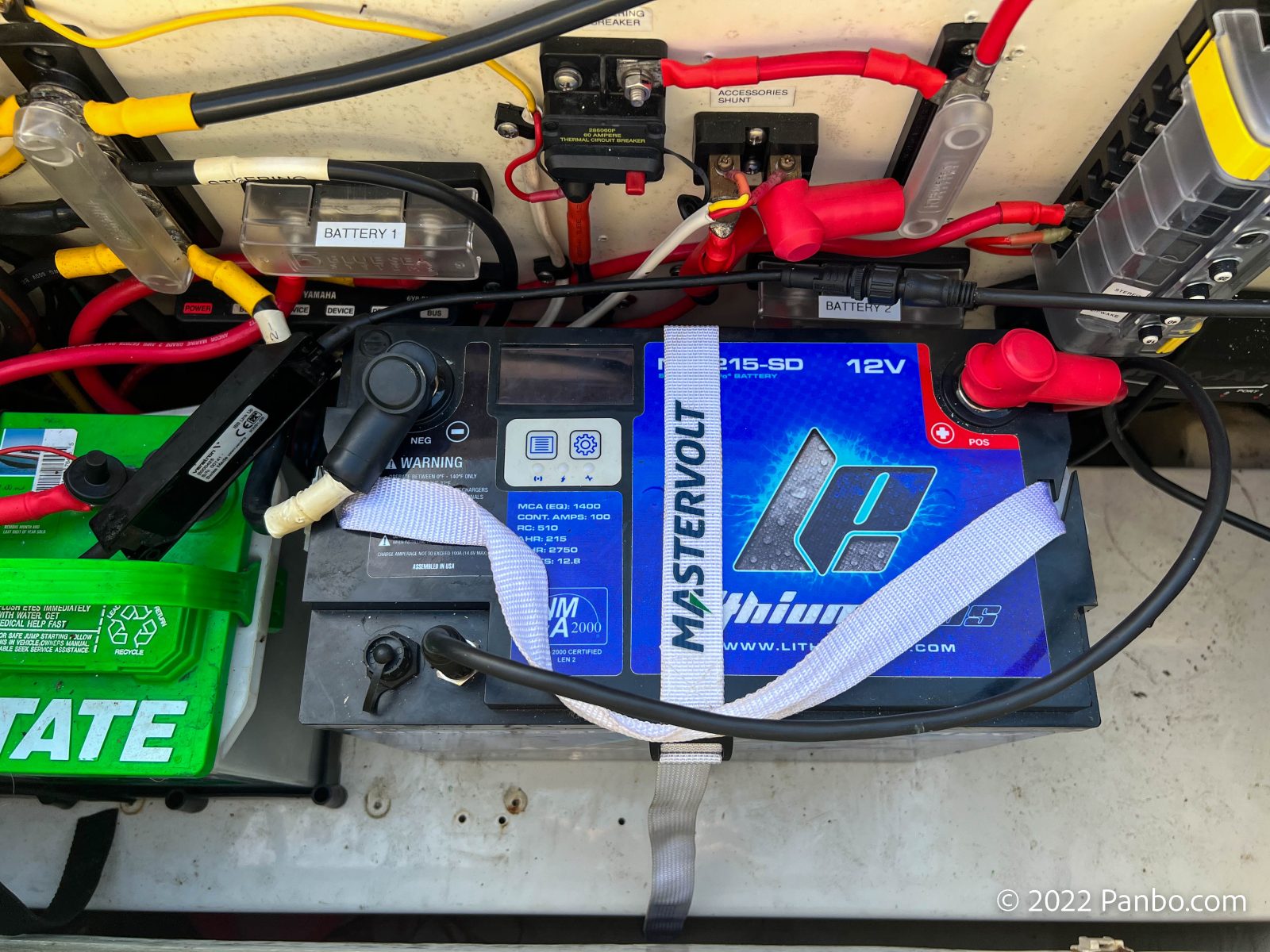
I’ve had a 215-amp N32215-SD battery on Panbo(at) since January and have been able to put the battery thoroughly through its paces. Batteries on Panbo(at) don’t live a particularly easy life. Since I bought the boat almost three years ago, it’s rarely been on a charger. Additionally, there are a lot of loads on this little boat, and the Yamaha F150 engine doesn’t have a very big alternator. So, I’ve been through a few lead-acid batteries in the time I’ve owned the boat and became accustomed to what the engine sounds like when cranking with a dying battery.
With the Lithium Pro in place, the engine has never hesitated while starting. More importantly, all evidence of voltage sag during starting has also disappeared. With lead-acid batteries, it was not uncommon for the MFDs and other electronics to reboot when starting the engine. That was caused by the voltage of the battery sagging due to the large, momentary load of the engine starting. As I’ve seen in several other LiFePO4 installations, the battery’s voltage doesn’t dip under heavy load.
The battery sits beside a lead-acid cranking battery. Each battery connects to one of the positions on the 1/2/Both/Off battery switch. I typically don’t ever run the batteries in the both position. But there’s one scenario where that position comes in very handy. The BMS on the battery disconnects itself if the battery sits unused for longer than 21 days. To wake the battery up, you connect a charge source to the terminals, and the BMS comes back to life. That’s well and good, but kind of a pain if you’re not close to an outlet and charger. So, instead, I’ve been able to swing the battery switch to both and use even a weak lead-acid battery to wake up the LP battery.
Capacity test
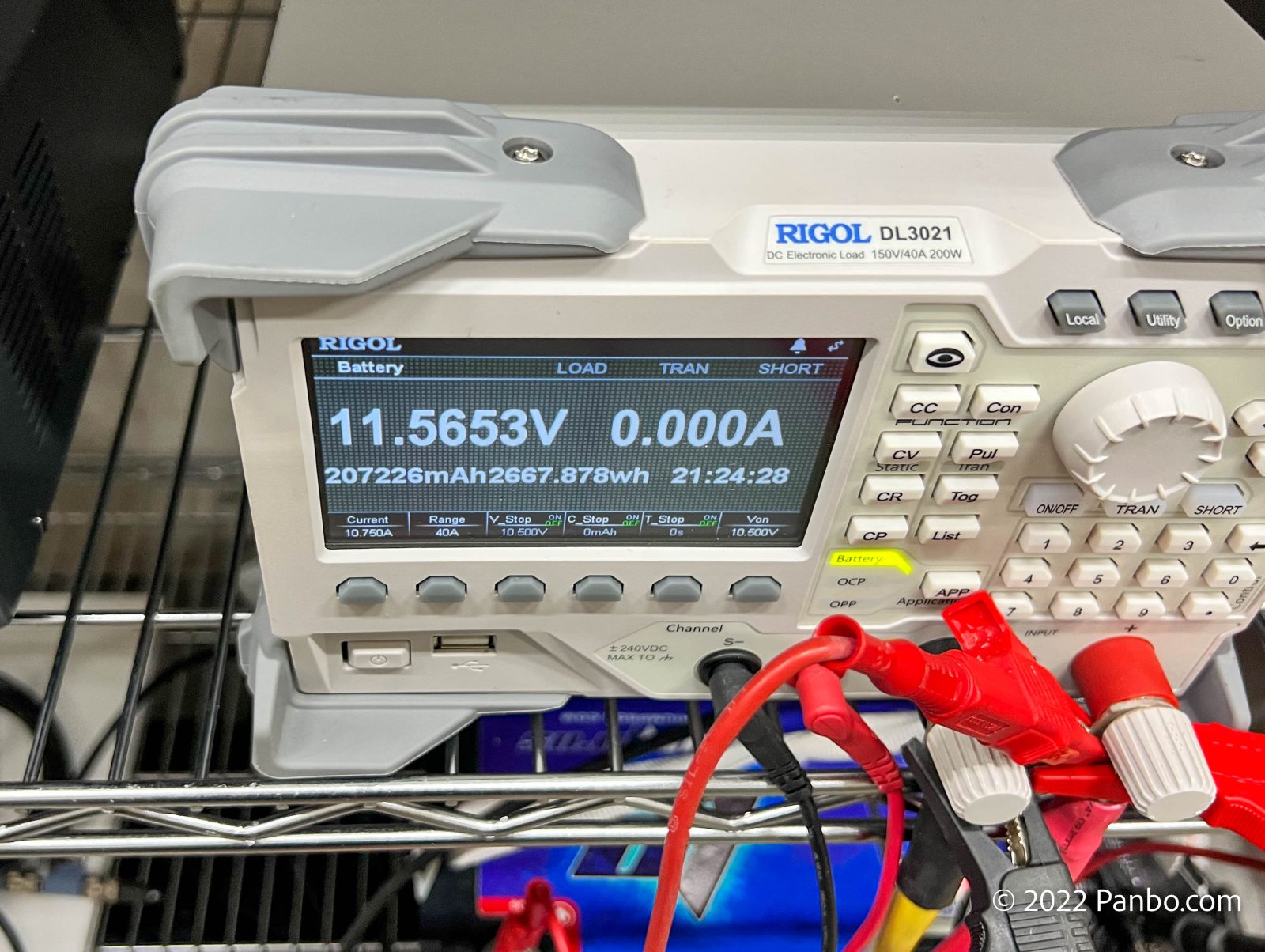
Before installing it and again after using the battery for nearly a year and running more than 17,000 amp hours through the battery, I did a capacity test on it. I did fairly kind tests and stopped them at 10.5 volts rather than letting it get down to the BMS cutoff. Brand new, the test showed a capacity of just under 212 amp hours. After 11 months, the test showed a capacity of just over 207 amp hours. I’m pretty sure that if I’d run the battery to its cutoff, even after a year, it would provide over rated capacity.
Tearing down a battery
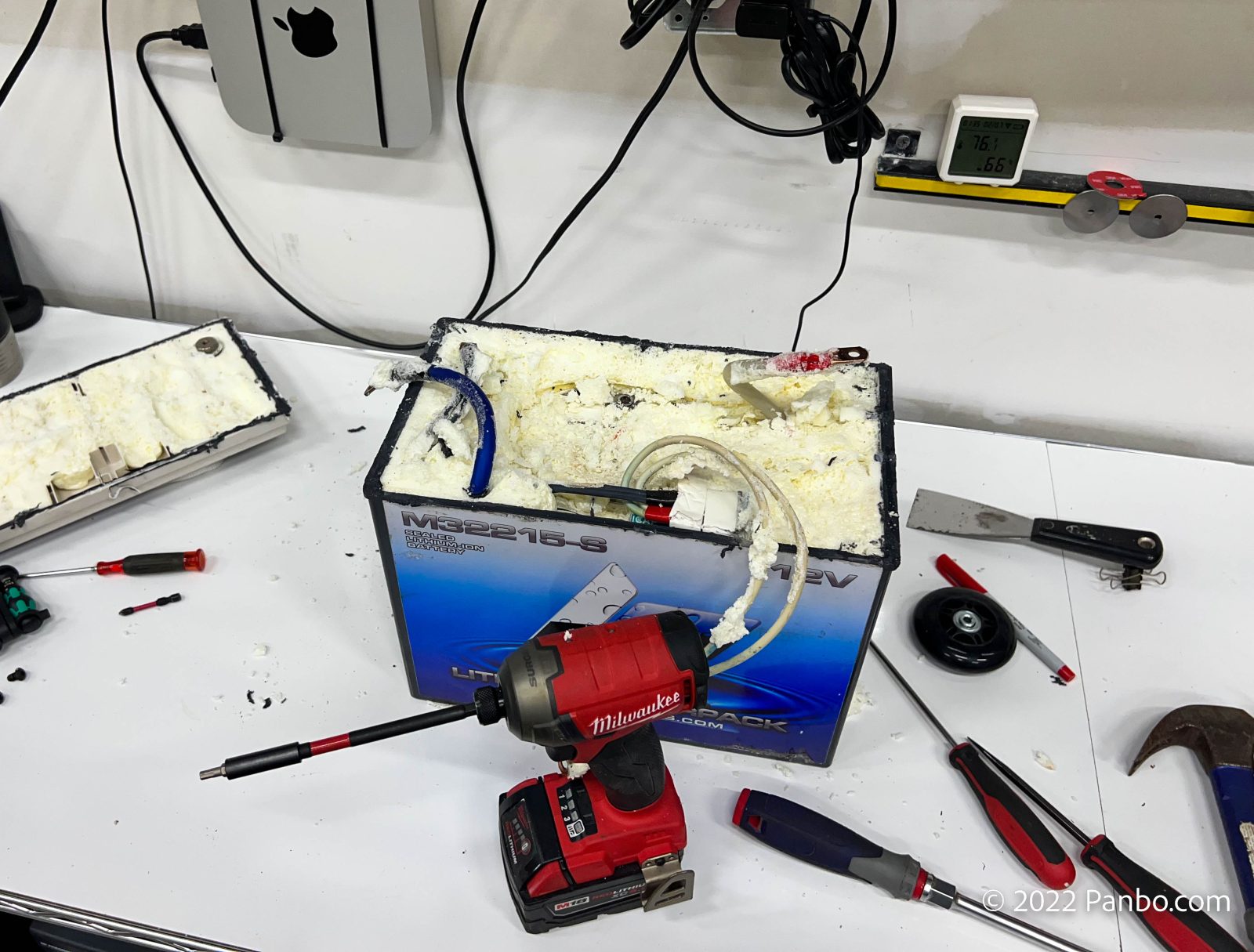
Whenever I test a battery, I also ask the manufacturer for a tear-down unit. A few have declined, and one manufacturer decided they no longer wanted me to test their batteries at all after I asked. Lithium Pros quickly sent me a unit to tear down. When a company provides a battery, I go into the tear-down, assuming I’m going to find a well-built battery. Who would provide a sample to tear down, knowing I’d find shoddy work or low-quality components? LP’s battery didn’t disappoint.
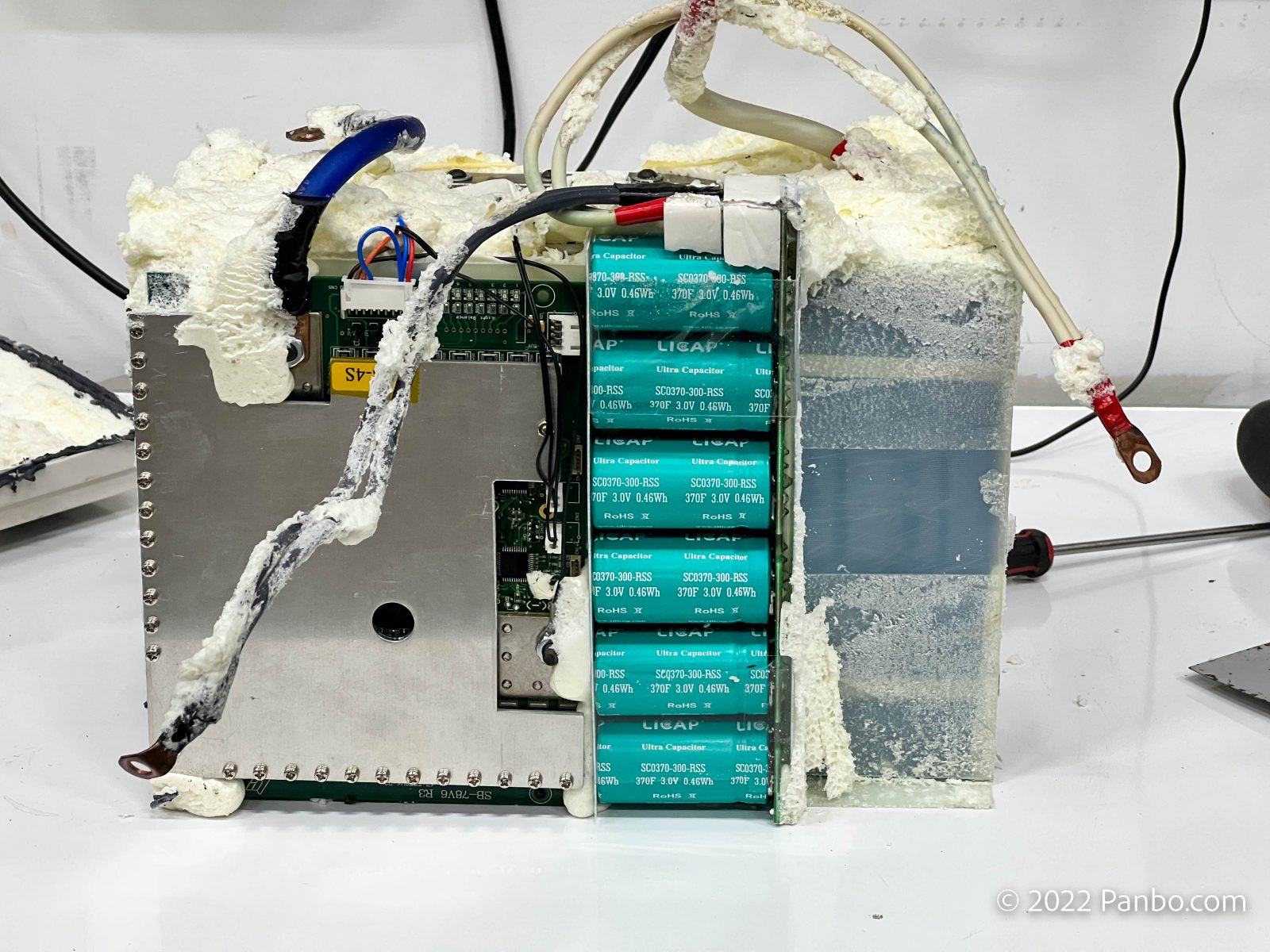
I was expecting to find high-quality components, and that’s just what I found. The battery consists of three major components. Two are quite familiar in looking at any LiFePO4 battery, and one is quite new. The LiFePO4 cells and battery management system (BMS) are found in any decent LFP battery. But, in a first for any lithium battery I’ve come across, Lithium Pros uses a set of supercapacitors or supercaps in all their starting-rated batteries. We’ll talk more about those super caps in just a minute.
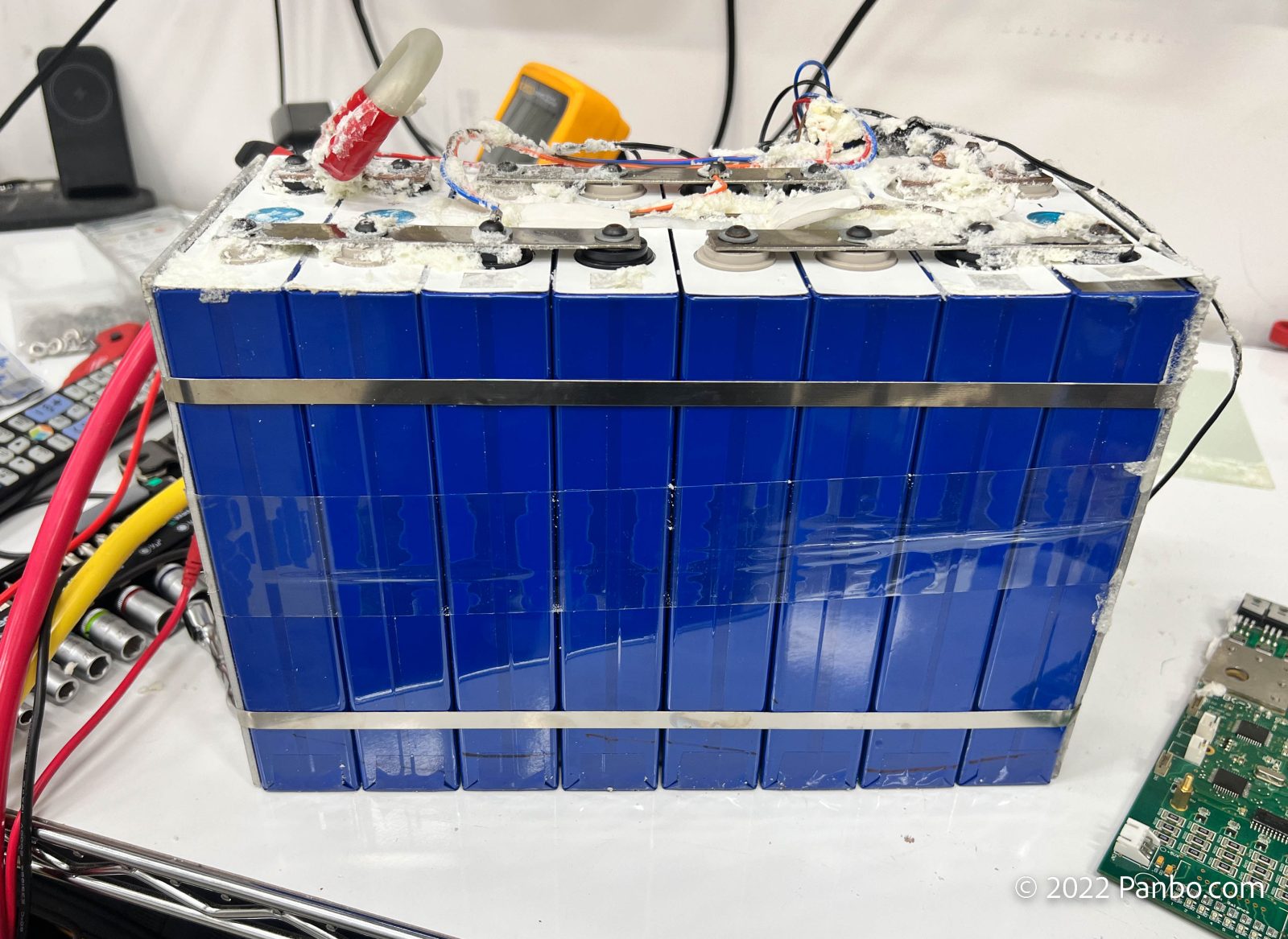
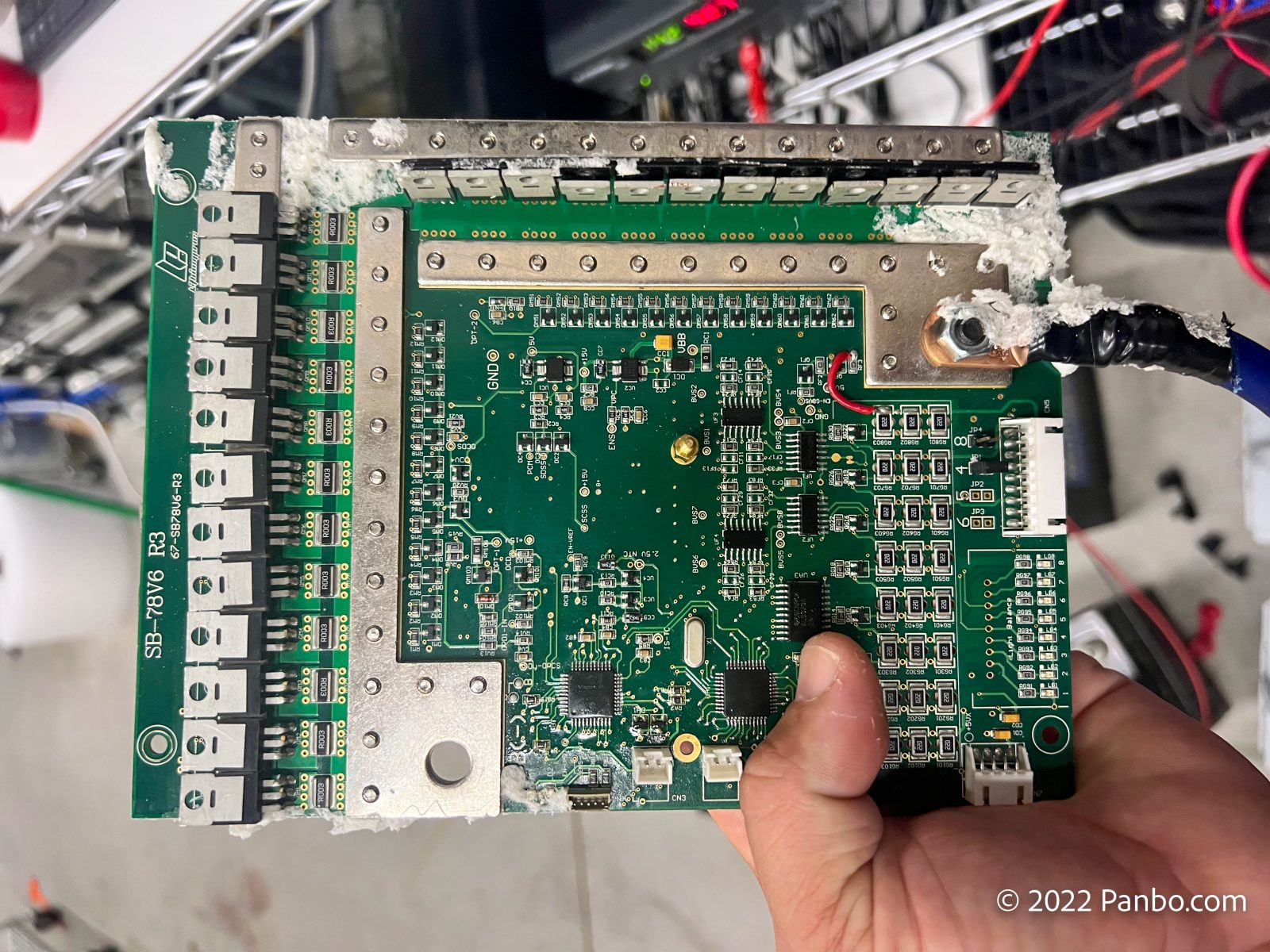
The 215 amp-hour batteries consist of 8 105 amp-hour cells from a reputable cell manufacturer. The cells are arranged in 4 parallel pairs connected in series. The BMS sits inline on the negative leads from the cells.
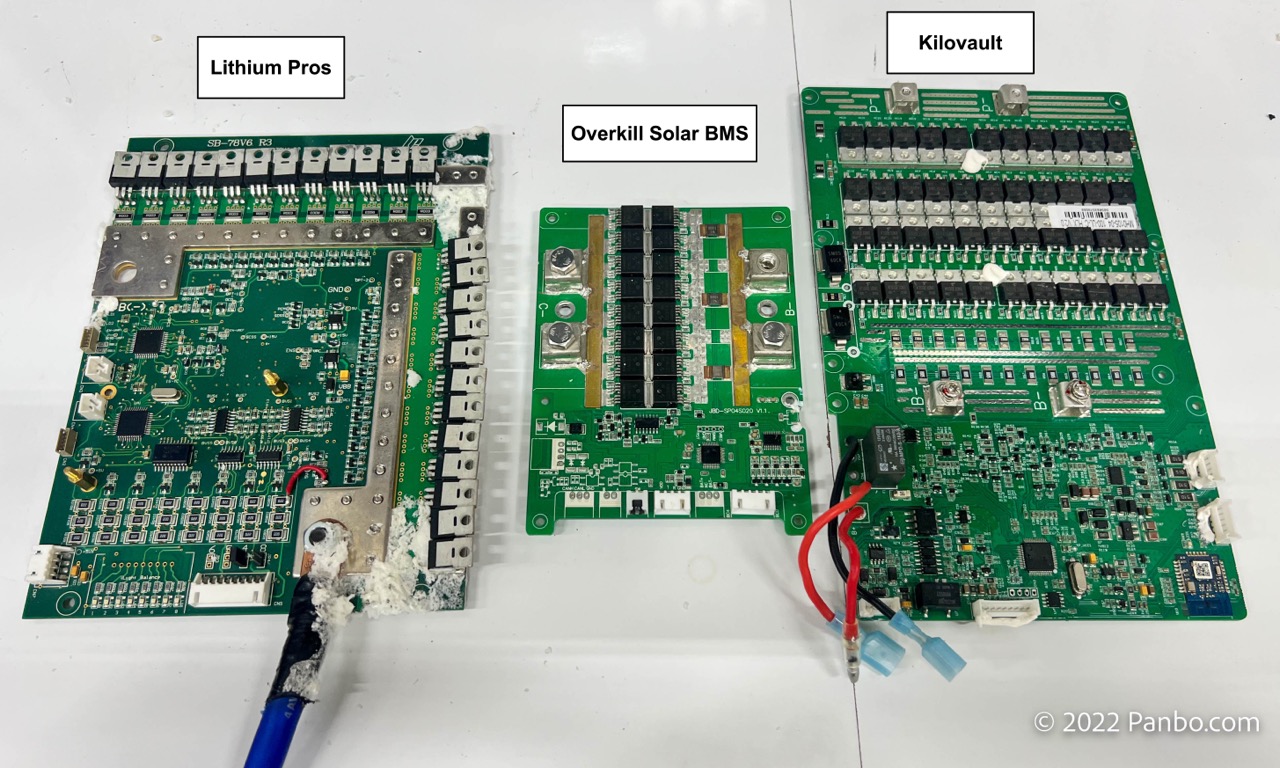
A heat sink covers the entire Lithium Pros BMS. Each FET (current-controlling transistor) on the BMS attaches directly to the heatsink to ensure maximum heat dissipation. As I mentioned in my review of KiloVault’s batteries, heat is the enemy of the BMS and particularly FETs. The LP BMS has fewer FETs than KiloVault’s, but their heat appears more thoroughly controlled with the direct connection to the heat sink.
Supercapacitors make starting easy
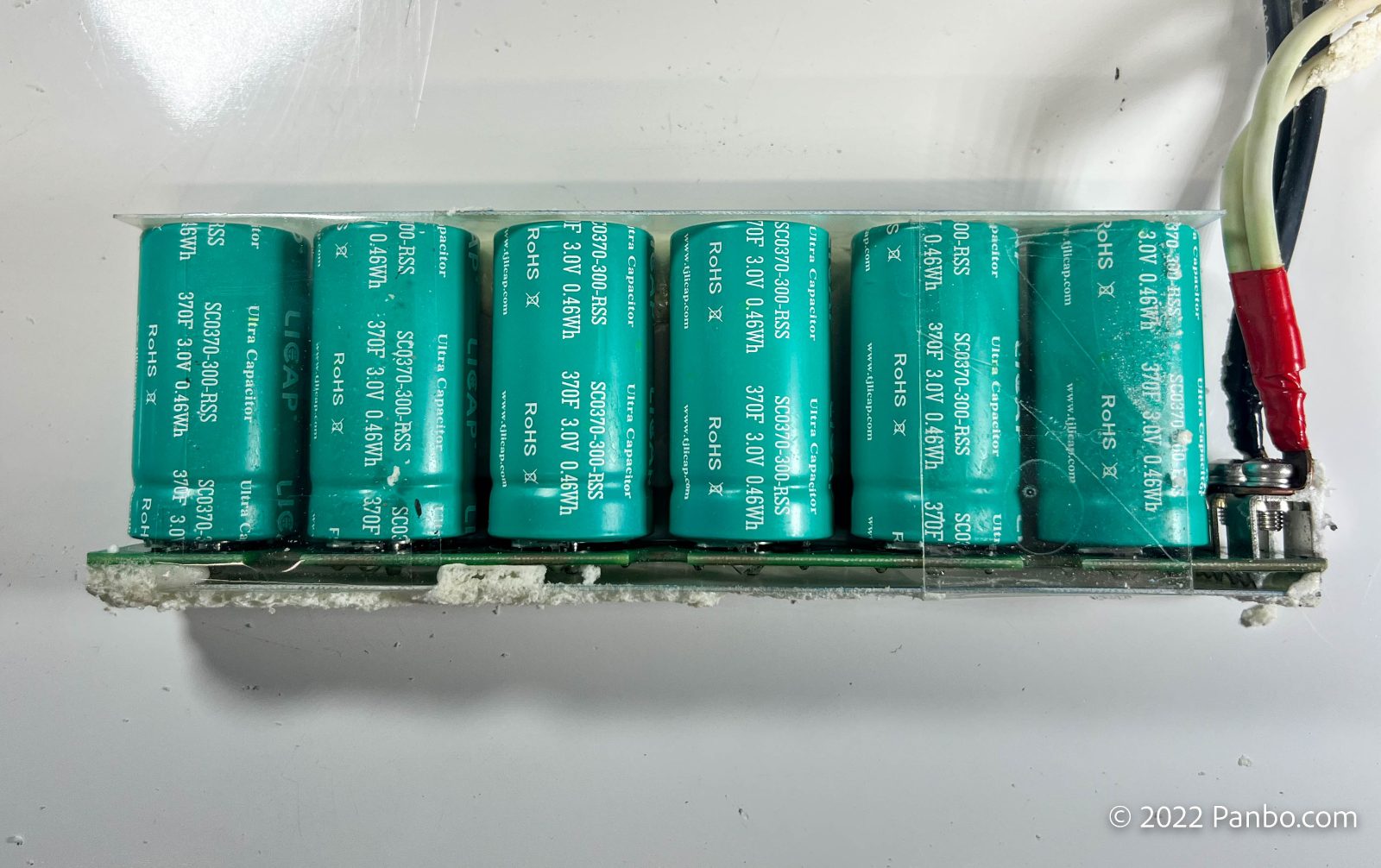
Here’s where Lithium Pros is doing something new, at least to me. The challenge of starting an engine for most LiFePO4 batteries is the large inrush associated with getting the motor spinning. The starting load is momentary, but it can be hundreds of amps and exceed both the continuous and momentary load limits of LiFePO4 batteries. Supercapacitors can deliver a burst of lots of energy in a very short time.
Supercapacitors come with quite a few advantages, including their ability to deliver a burst of energy, rapid recharge, and cycle life. Lithium Pros uses supercaps rated for 1,000,000 cycles. That’s a lot of engine starting!
In addition to the benefits I’ve already described, Kevin Bennett, the founder of Lithium Pros, pointed out another important advantage of using supercaps. The supercapacitors connect directly to the posts on the enclosure. So, they connect to the circuit after the BMS. That means that even if the BMS disconnects due to a fault condition, the supercaps stay in the circuit.
Supercaps after the BMS yields two major advantages. First, even if the BMS has disconnected the cells, the supercaps will be able to start the engine. In fact, Kevin Bennet reports that either the cells and BMS or supercaps can start an engine if the other fails. Second, one of the biggest concerns with directly connecting any BMS-controlled battery to an alternator is protecting the alternator in the event of a load dump.
Without supercaps, if the alternator is working hard to charge the battery and the battery disconnects, the energy generated has nowhere to go. The result is potential alternator damage. But, when the supercaps are in the circuit, they will serve as a snubber or protection for the alternator. When the alternator is producing charge current, if the battery is suddenly disconnected, a load dump occurs. With nowhere for the generated energy to go, the alternator’s voltage will spike until the regulator can stop sending current to the field windings. That event is likely to damage the alternator’s protection diodes. Instead, with the supercaps in the circuit, they will the energy as the voltage rises in a controlled manner. The alternator’s regulator will be able to pull back field current before any damage occurs.
Putting it all together
An energy-dense LiFePO4 battery isn’t new, and plenty of other manufacturers make them. But a battery with NMEA 2000 connectivity, a built-in, detailed display, and engine starting is, as far as I know not available from anyone else. Comparing batteries on a per watt-hour basis, these are premium batteries. But, they’re delivering premium functionality and solving problems no other battery can currently.




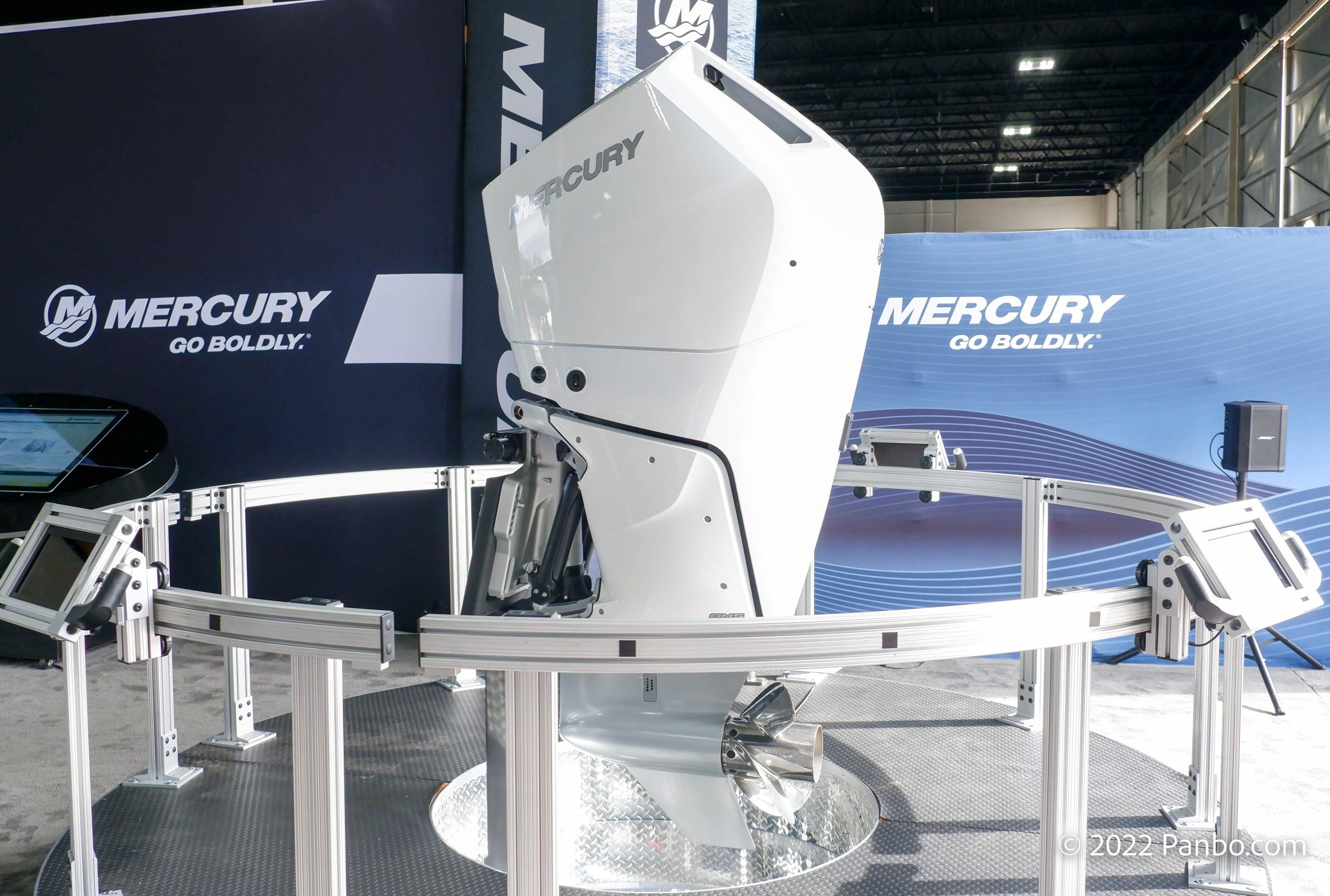







Will the N2k connection sum the totals of a parallel bank or is it just for use with one battery?
Each battery is addressable on the NMEA 2000 network individually. So two batteries in parallel would show up as two entries in the list of devices. Choose to display information from one or both.
Hi Ben, great article and looks like a great product. I currently have 3 dead Group 31 AGMs in the back of my Jeep. They were the start batteries for my Foretravel Motorhome. They weigh over 70 lbs each. Thought these batteries may be a fit for me to match up with Li House batteries but at $2K each or 6K Total, guess I will continue on to Sam’s Club and pick up some more AGMs at $135 per copy. Sure could supplement my House Batteries nicely though.
I am no longer boating, but still follow Panbo looking forward to your articles. Keep up the good work and thanks. Herb Stark
I’m glad to read your review of LP’s marine batteries. I purchased, a year ago, two RE 129ah for our Class C RV. I am well pleased with their performance. I understand that the BMS is internal with no external readout like the one you have reviewed. I don’t know of an app to check performance of the RE line. Any suggestions for adding a monitor would be appreciated. Thanks again
Well, Yet Another Great Article! That you actually did capacity tests AND a tear-down in addition to in-situ testing is one of the reasons I appreciate your in-depth investigations and well written reviews.
As for these new batteries from Lithium Pros… FINALLY! Someone has integrated super caps (or ultra caps) into a battery for engine starting, not to mention their other benefits. This is something I’ve contemplated for many years. I tried to buy some Maxwell Technology super capacitors a few years ago to experiment with, but the big ones are hard to source for an individual. And I suspect that most that you see on Amazon and Alibaba are counterfeit and/or unknown quality. Anyway, your tear-down reveled the ultra cap secret in these batteries and good quality ones at that. And nice BMS, too. The number of FETs, attention to heat dissipation and big bus bars are indicative of a robust design.
(Note, that with no option for an internal heater these batteries would not be appropriate for active use in freezing temps or below. Probably noted in the manuals.)
I know some may balk at the price, but when I consider the quality of the cells, BMS, ultra caps, NMEA networking and the engineering that went into these products I think it is reasonable.
That said, I would like to see someone make a small (i.e. group 24 or smaller) battery that was more ultra cap and less Li cells for starting my sailboat engine (39hp), at a attractive price. Maybe that’s the model C682?
Good job Ben, and good job Lithium Pros for the innovation.
I am curious how the charge current was limited. I work on Yamaha engines and there charging is not the best. The Lifepo4 batteries I have installed in the past require a special alternator or a DC to DC converter to limit the amperage draw on the charging system. Is this built into these batteries?
Charge current limiting is not built into the battery.
Your article motivated me to google superconductors. There appear to be lots of standalone superconductors which could be added to existing battery banks (thank the idiots whose bass shakes the whole parking lot) So you can have the advantage of the LiPro battery on your existing battery bank.
Supercapacitors. Mind-blowing! I wonder how long until someone provides a true drop-in solution, by supporting high starting currents we are one step closer to emulating a lead acid battery, one that can also emulate the voltages of a lead acid battery including adjusting the output voltage to accurately reflect the battery state of charge so well our existing battery monitors function normally.
Hi Ben – Great article on a very interesting product. My question related to using these batteries in a house bank configuration. Is there any limit to the number of 110Ahr batteries that can be paralleled? I’m interested in paralleling 4 batteries.
The battery in the article is designed for engine start and is therefore limited to 2 units maximum in parallel. They are really intended for individual operation. We are working on a different product for larger, paralleled banks for energy storage.
This article rekindled my interest in using super-capacitors for cranking, and so I was poking around on the interwebs and found this product: https://www.fpv-power.com.au/products/12vsupercapacitorhybrid25ahbattery
A lot more basic than the Lithium Pro battery, and not suitable for house loads, but if you were looking for something to replace your start battery this is interesting with a price that is comparable to an AGM. Might not be available out side of Australia, though.
Question: What device did you use for the capacitance test?
Hi Larry,
I’m using a Rigol DL3021 (https://www.rigolna.com/products/dc-power-loads/dl3000/). It can be controlled by computer, creates a log of the capacity runs and more. It has worked out quite well for my testing.
-Ben S.
We have been using these for some time as a starting battery. On the farm we use it on all the tractors including a Case 580 backhoe. WAY better than lead. Addressing Ben’s concern about running out of charge, checkout the “re-start” feature. https://antigravitybatteries.com/products/starter-batteries/restart-oem/atx30-rs/
That’s a clever feature. Boats, in particular, with the usual two or more batteries may not find it as useful as will single battery mobile equipment and, possibly vehicles.
Where are Lithiumpros manufactured?
Kevin, I am confused over some features Ben wrote about. Ben wrote ” if the BMS disconnects due to a fault condition, the supercaps stay in the circuit.” and went on to explain some benefits that confused me.
(1) “if the BMS has disconnected the cells, the supercaps will be able to start the engine”. Won’t the supercaps substantially discharge from the time of disconnect through the several minutes an owner might need to check on an alarm, diagnose they need to start the engine, and start the engine? Particularly on a sailboat under way there could be items like an MFD, other displays, AIS, navigation lights, a fridge?
(2) “Without supercaps, if the alternator is working hard to charge the battery and the battery disconnects, the energy generated has nowhere to go. The result is potential alternator damage. But, when the supercaps are in the circuit, they will serve as a snubber or protection for the alternator.”. Presumably the super caps are 100% charged if the alternator is running (or is it not?). E.g. if the LifePO4 battery is 80% charged isn’t the supercap likely to be 100% charged? At full charge, how do fully charged supercaps absorb a significant amount of voltage spike from a load dump?
I’m hoping Kevin might answer on the first question, but I think the reality is that if you have house type loads on the battery, you’re likely to quickly deplete the supercaps and still have a problem starting the motor. On the other hand, if the loads are low on the battery, it could well keep you out of trouble.
For your second question, I think I can chime in. The bank of supercaps is made of six 3.0 volt caps. That’s an 18 volt bank. But, the bank will be held at the voltage of the charge energy coming into the battery. That’s likley to be around 14 volts. In a disconnect event, the batteries would stop accepting charge. As a result of that charge not having anywhere to go, voltage would rise. With 4 volts of “headroom” the voltage would rise momentarily, and the supercaps would absorb that voltage. At the same time, the regulator of the alternator (internal or external) would see the rising voltage and pull back field to shut down production. That would happen in time, and the alternator would be preserved. At least, that’s my understanding.
-Ben S.
Yes, that makes sense.
The supercaps idea is interesting but I’d like to know how it would work with a thruster (or if LPs battery is ok to use with thrusters…).
I have a 40′ Mainship and the current wiring is designed to have the thrusters on the house bank instead of the engine start bank. It would take a fair amount of work to separate this and I do kind of like that design. Could these batteries deal with the amperage of bow and stern thrusters docking?
Hi Alex, I’m not as knowledgable about LP batteries as Ben Stein, but I do have a thruster that’s running fine on a LiFePO4 house bank. Specifically, I’ve got four 100A Victron Lithium Smarts heavily cabled to a Lewmar 4kw TT185. The batteries are rated at 200A maximum continuous discharge each, with 100A recommended, while the thruster can purportedly suck up 470A.
So, at least theoretically, I’m slightly exceeding the 400A recommended maximum discharge rate of my bank, but then again I’m almost invariably running the engine when using the thruster so the house bank alternator is adding another 100A plus. Also, I’ve never seen anything close to 470 amps on the bank’s current monitoring, which I suspect is a combination of shunt inaccuracy with short bursts of high amperage and Lewmar possibly overstating the power draw so installers don’t scrimp on cable sizes.
At any rate, my battery system has not complained and, in fact, the thruster seems a little zippier, as do all boat’s other electric motors (thanks, I think, to the higher LiFePO4 voltage).
I am planning one LIPO4 alongside a lead acid cranking in order to run dual Yamaha 150’s with the Perko switch on 1+2. the below statement about alternator damage or overcharge has me concerned. I have big drain currently on one of the Yamaha LA batteries due to all the electronics and live well electric draw so wanted to switch out that one with lifPO4. Any thoughts?
**************
William Hitchen stated December 15, 2022 at 10:39 pm
“I am curious how the charge current was limited. I work on Yamaha engines and there charging is not the best. The Lifepo4 batteries I have installed in the past require a special alternator or a DC to DC converter to limit the amperage draw on the charging system. Is this built into these batteries?”
Reply
Kevin Bennett December 21, 2022 at 10:47 am
“Charge current limiting is not built into the battery.”
read a recent article that stated a battery isolator is needed in between the cranking lead acid and the lifepo4 deep cycle to be connected together in order to charge from my outboard alternator and the boat system?
hers the article about the isolator needed. https://battlebornbatteries.com/battery-isolator-with-lithium-lead-acid/
I am curious if these batteries could be safely charged by an older charger that doesn’t have a lithium battery profile?
We have an older charger/inverter that can work with flooded, AGM, or gel but Xantrex recommended to not use Li unless it was compatible with an AGM profile.
Would the super caps allow this battery technology to be charged by one of the traditional charging profiles? That would be great. Even though these batteries are more expensive than other lithium batteries when the cost of replacing the charger/inverter is includes this may be a good deal.
John,
I wouldn’t advise that you try and charge these, or any other LiFePO4 battery, with a charger that you can’t adequately control. The supercaps aren’t going to do anything to reduce the voltage that the cells see. In fact, the supercaps are actually rated for higher voltage, so they will happily increase their voltage if the charger does, but that increased voltage will also make it to the BMS and cells. At a minimum, that will cause a high-voltage disconnect event.
My biggest concern would be that most chargers aren’t transparent around temperature compensation. If the inverter/charger is temperature compensating, the voltage will increase and, as I mentioned, the supercaps won’t do anything to stop that increased voltage from making it to the batteries.
-Ben S.